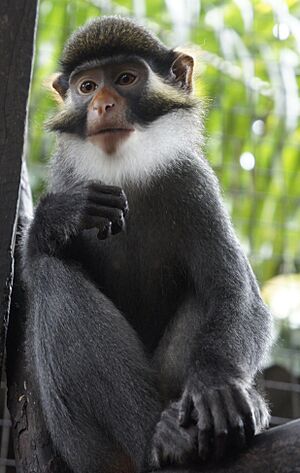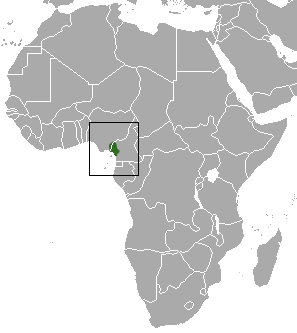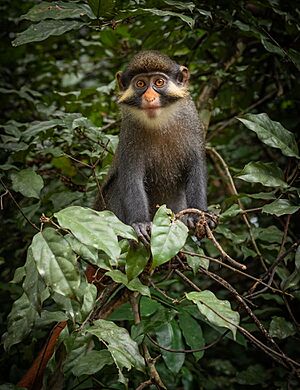Red-eared guenon facts for kids
Quick facts for kids Red-eared guenon |
|
|---|---|
 |
|
| Conservation status | |
| Scientific classification | |
| Genus: |
Cercopithecus
|
| Species: |
erythrotis
|
 |
|
| Red-eared guenon range | |
The red-eared guenon (say "GWEH-non"), also called the red-eared monkey or russet-eared guenon, is a type of primate (like monkeys and apes). It belongs to the monkey family called Cercopithecidae. These monkeys live in warm, wet lowland forests. You can find them in countries like Cameroon, Equatorial Guinea, and Nigeria.
The red-eared guenon is listed as a Vulnerable animal on the IUCN Red List. This means its population is decreasing. They are threatened because their forest homes are being destroyed. They are also hunted illegally and sometimes caught to be sold as pets.
Contents
What Does a Red-Eared Guenon Look Like?
The red-eared guenon is a small and very colorful monkey. It has special markings on its face. The fur around its eyes is blue, and its nose and ears are a bright brick-red color. Its cheeks are yellow.
The fur on its body is soft and silky. It has bands of brown and pale hairs. Its arms and legs are grey, and it has a long, red tail.
Size and Tail
Their long tails can grasp things a little bit. Baby guenons use their tails to hold onto their mothers. This monkey is usually quiet and doesn't make loud calls like some other guenons.
Male red-eared guenons are about 42 centimeters (16.5 inches) long from head to body. Their tails can be about 61 centimeters (24 inches) long. Females are a bit smaller. Their head and body length is about 38 centimeters (15 inches), and their tails are around 55 centimeters (21.7 inches) long.
Where Do Red-Eared Guenons Live?
There are two main types, or subspecies, of the red-eared guenon. They live in different areas:
- Cercopithecus erythrotis camerunensis: This type is called the Cameroon Red-eared Monkey. It lives near the Cross River in southeastern Nigeria. It also lives just north of the Sanaga River in southwestern Cameroon.
- Cercopithecus erythrotis erythrotis: This type is called the Bioko Red-eared Monkey. It lives on Bioko island, which is part of Equatorial Guinea.
Their Forest Home
Red-eared guenons live in both old, untouched forests and newer forests that have grown back. They prefer warm, wet forests in low-lying areas or on the lower parts of mountains. Sometimes, they even live close to people, especially on Bioko island.
How Red-Eared Guenons Live
Red-eared guenons are omnivores. This means they eat both plants and animals. They have been seen eating fruits, leaves, and young plant shoots. They also eat insects, which are very important for their health. Insects are especially helpful for mothers who are pregnant or feeding their babies.
Social Life
These monkeys usually live in groups. A group typically has at least one adult male and about ten females with their young. Their groups are not as strict or bossy as some other monkey societies.
Red-eared guenons are territorial, meaning they protect their living area. However, they usually try to avoid fights with other groups of monkeys.
Reproduction and Life Cycle
Scientists don't know a lot about how red-eared guenons have babies. But, similar monkey species usually give birth to one baby every one to three years. Pregnancy for these types of monkeys lasts about five or six months.
Why Red-Eared Guenons Are in Danger
The red-eared guenon faces serious threats that put its future at risk.
Habitat Loss
One big threat is deforestation. This is when forests are cut down for farming, logging, or building. When their forest homes disappear, these monkeys lose their food and shelter.
Illegal Hunting
Another major threat is the illegal hunting of these monkeys for their meat. This is often called the "bushmeat" trade. It is a big problem, especially on Bioko island. Many red-eared guenons are found in markets where bushmeat is sold. In 2006, it was estimated that about 3,400 red-eared guenons were hunted each year in the forests along the coast of Cross-Sanaga-Bioko.



